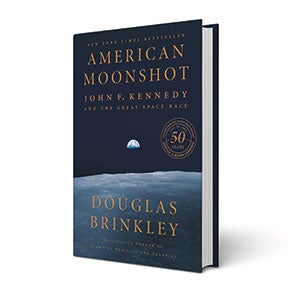Book: American Moonshot

In 1961, President John F. Kennedy pledged to put a man on the moon before the decade’s end. Fifty years ago this summer, his lunar ambition was achieved — just five months shy of that target and more than five years after his death.
The case has been made that America’s obsession with reaching the moon was a romantic rather than a scientific pursuit — an extraterrestrial embodiment of manifest destiny. That doesn’t mean it wasn’t worthwhile, says historian Douglas Brinkley.
“It’s fair to argue that NASA’s Projects Mercury, Gemini, and Apollo were just a shiny distraction, that the taxpayers’ revenue should’ve been spent fighting poverty and improving public education. But it’s disingenuous to argue that Kennedy’s moonshot was a waste of money,” writes Brinkley, the Katherine Tsanoff Brown Professor in Humanities. “The technology that America reaped from the federal investment in space hardware … has earned its worth multiple times over.”
In “American Moonshot,” Brinkley explores how Kennedy’s singular vision, bolstered by a “rare combination of leadership, luck, timing and public will,” allowed him to pull off one of the most ambitious, audacious achievements in history, and to take a giant leap forward not just for America, but for all humankind. — Jennifer Latson
Epilogue: The Triumph of Apollo 11
Excerpt of “American Moonshot: John F. Kennedy and the Great Space Race” by Douglas Brinkley, used by permission of HarperCollins Publishers.
In the hot summertime of 1969 NASA’s three-staged Saturn V rocket blasted off from Cape Canaveral. That July 16, the Apollo 11 crew headed to the moon, and Kennedy’s dream inched even closer to reality. Retreat wasn’t an option for there was no turning back. To honor the state of Texas, the three astronauts, Buzz Aldrin, Neil Armstrong, and Michael Collins, had brought a Lone Star flag with them on the mission. Armstrong also brought along a wing fragment extracted from the Wright brothers’ famous Kitty Hawk plane as a good luck charm. …
On July 20, a gangly LEM dubbed Eagle descended forward on a flat lunar field named Sea of Tranquility. In a moment of high tension radioed live into living rooms on Earth, the astronauts reported that their descent engines were kicking up dust. The first words spoken on the moon were “contact light” from Aldrin. This referred to an Eagle sensor that had lit, as anticipated, inside the lander. This was followed by Armstrong saying the iconic “Houston … Tranquility Base here. The Eagle has landed.”
At the NASA Manned Spacecraft Center, all the technicians erupted in spontaneous cheers. Time itself, it seemed, had stopped the second Armstrong had uttered those unforgettable words. The score was the United States had landed, and the USSR had not — game over. It was as if a new millennium had opened up for the world to embrace with awe and wonder.
While Armstrong and Aldrin walked the lunar surface, Collins had been left piloting the Columbia command module around the moon. On his silent trip along the far side, he wrote, “I am absolutely isolated from any known life. I am it. If a count were taken, the score would be three billion plus two over the other side of the moon, and one plus God knows what on this side.” …
The 528 million moon-mad global citizens who watched the historic spectacle on TV delighted in human achievement. It was as if America’s sins in Vietnam had been forgotten for a while. The astronauts wandered only a few hundred feet from the Eagle. But they opened up the moon for future travelers. “This is the greatest week in the history of the world since the creation,” President Nixon enthused to the astronauts with a broad grin of satisfaction. “As a result of what you’ve done, the world has never been closer together before.”
NASA had beaten by five months President Kennedy’s pledge to put a man on the moon by the decade’s end. After more than eight days in space, the Apollo astronauts splashed into the Pacific. At Mission Control in Houston, a sentence from JFK’s May 25, 1961, special message to Congress flashed on the large headquarters screen: “I believe that this nation should commit itself to achieving the goal, before this decade is out, of landing a man on the moon and returning him safely to the earth.” An Apollo 11 logo also appeared on the NASA screen, offering the greatest honor of John F. Kennedy’s public career: “Task Accomplished July 1969.”
At around that time, an unknown citizen had left a lovely bouquet of flowers on Kennedy’s Arlington grave with a thoughtful card that read simply: “Mr. President, the Eagle has landed.”
— Douglas Brinkley
